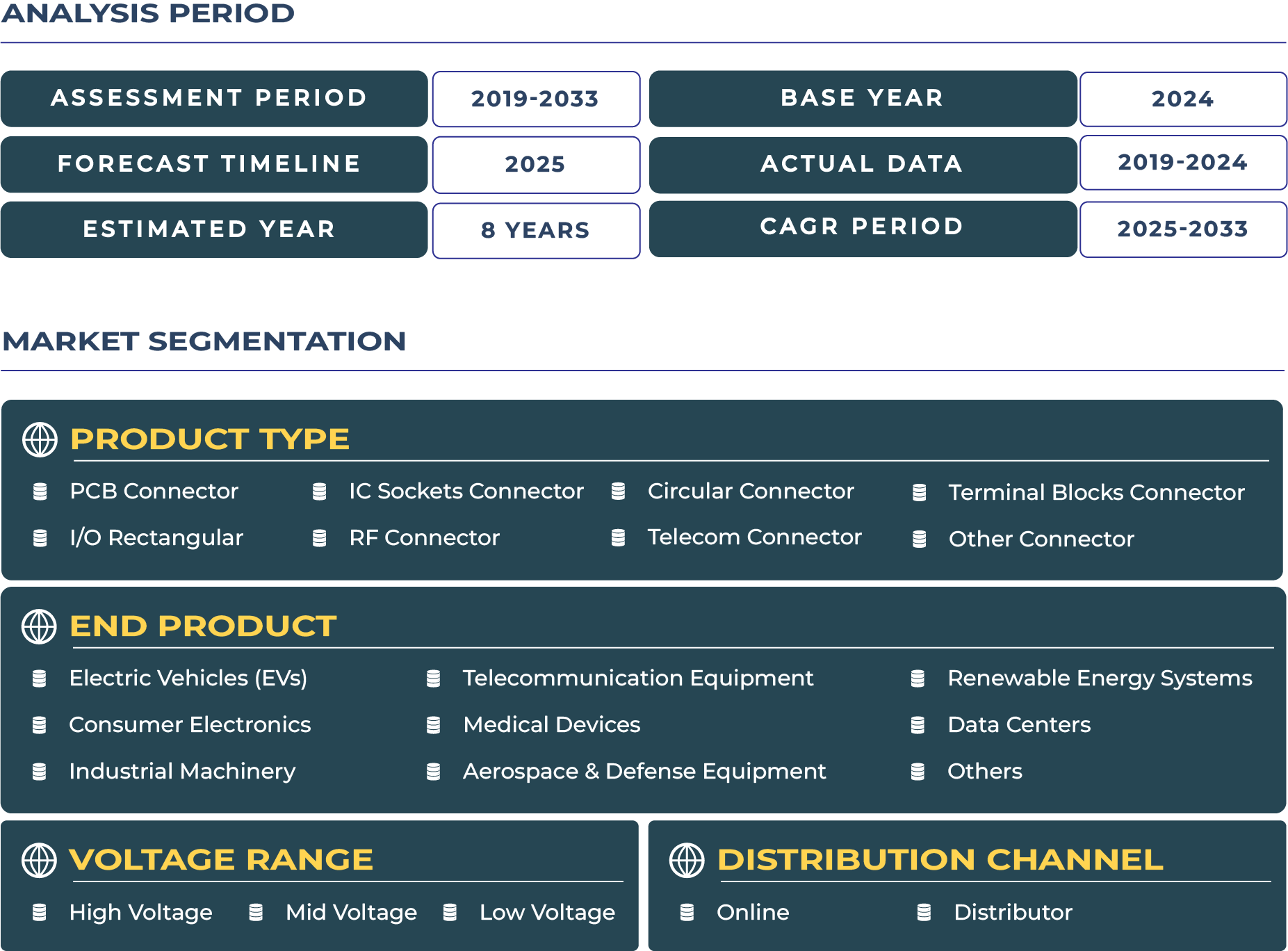Report Format:
![]()
![]() |
Pages: 110+
|
Pages: 110+
India Connector Market Outlook
India connector market is witnessing accelerated momentum, projected to reach a value of approximately $8.79 billion by 2033, expanding at a CAGR of around 8.6% during the forecast period. As per David Gomes, Manager – Semiconductor, this surge is closely tied to India's rapid digitization, domestic manufacturing incentives under the Make in India initiative, and increasing demand from sectors like automotive, electronics, telecom, industrial automation, and renewable energy. The country’s ambitious drive toward electric mobility, smart infrastructure, and 5G rollout is unlocking multi-sectoral opportunities for connector manufacturers, both local and global.
The growth in the Indian connector market is not just volume-driven but value-oriented, spurred by adoption of miniaturized, high-speed, and ruggedized connectors catering to next-gen applications. The automotive sector remains a cornerstone, with EV production volumes expected to touch 14 million units by 2030, demanding robust connectors for battery management systems, powertrain components, and vehicle-to-infrastructure communication. Leading OEMs such as Tata Motors and Mahindra Electric are shifting toward high-voltage interconnects, while startups like Ather Energy are standardizing IP67-certified waterproof connectors for Indian monsoons. This is prompting tier-1 connector suppliers like Molex India and TE Connectivity to invest in local manufacturing hubs in Pune and Chennai, enabling faster lead times and improved cost efficiency.
The industrial automation and factory digitization push is another critical demand driver. The increasing deployment of Industrial Internet of Things (IIoT) and SCADA systems in smart factories and logistics parks is creating sustained demand for M12, M8, and fieldbus-compatible connectors. With India smart manufacturing market projected to surpass $38 billion by 2033, connectors that offer EMI shielding, vibration resistance, and modularity are seeing higher uptake. Similarly, the telecom sector’s shift to 5G networks and fiber-optic backhaul is spurring demand for optical connectors like LC, SC, and MPO, which support low-latency, high-bandwidth applications. The BharatNet Phase II and 4G Saturation Project are already boosting procurement contracts for rugged connectors in remote terrains, offering a multi-year revenue stream for connector vendors.
From a policy standpoint, government initiatives such as PLI for IT hardware, Semicon India, and the National Policy on Electronics 2019 are catalyzing the localization of electronic component manufacturing. These incentives are pushing companies to backward integrate and source or manufacture connectors domestically, reducing import dependency from China and Taiwan. According to David Gomes, this is leading to a shift in supply chain realignments, with manufacturers investing in indigenous tooling, high-speed stamping machines, and automated crimping systems. India’s connector exports have also shown promising growth, particularly to the Middle East and ASEAN, due to competitive pricing, BIS-compliant quality, and enhanced lead-time management.
Technological innovation remains central to this market's evolution. New trends include push-pull locking mechanisms, PCB mount connectors, and surface-mountable flexible connectors that improve both durability and compactness. Local players like SIBASS Electric, Amphenol India, and Connectwell are focusing on niche segments like railways, solar grid interconnects, and aerospace wiring harnesses. The rise in renewable energy installations, with solar capacity alone crossing 100 GW, is further bolstering demand for weatherproof MC4 connectors, inline fuse holders, and surge-resistant terminal blocks.
Challenges, however, remain. India connector market must overcome issues like fragmented supply chains, price sensitivity, and lack of skilled assembly labor. High reliance on imported raw materials—especially copper alloys and high-temperature thermoplastics—leaves the ecosystem vulnerable to global price volatility. Moreover, counterfeit components in informal B2B channels dilute market confidence. Addressing these bottlenecks will require industry collaboration, certification awareness, and infrastructure upgrades in tier-2 and tier-3 cities where most manufacturing parks are emerging.
Overall, India connector market is maturing beyond basic applications into strategic enablers for digital transformation and industrial resilience. With a strong foundation built on policy support, end-user demand, and infrastructure upgrades, connector companies that align their portfolios with next-gen use cases—ranging from EVs and IoT to space tech and green energy—stand to benefit the most in this growth phase.
Authors: David Gomes (Manager – Semiconductor)
*Research Methodology: This report is based on DataCube’s proprietary 3-stage forecasting model, combining primary research, secondary data triangulation, and expert validation. [Learn more]
India Connector Market Scope







